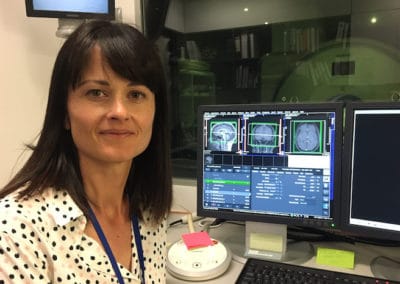Assoc Prof Ping Liu has been researching L-arginine, a highly versatile semi-essential amino acid, for almost 20 years – and it doesn’t sound like she’ll get tired of it anytime soon.
L-arginine is widely present in our bodies, including our brains. What makes L-arginine so fascinating, Ping explains, are the different products or bioactive molecules it turns into. There is, for example, a molecule called nitric oxide that is critical for synaptic plasticity, learning and memory, and cerebral blood flow. Other products, such as agmatine and polyamines, play an important role in neurotransmission and are essential for maintaining normal cellular function. And interestingly, Ping’s research has implicated the alteration of brain arginine metabolism in the pathogenesis of neurodegenerative conditions, such as Alzheimer’s disease.
Coming from a medical background, Ping is especially interested in how arginine metabolites might help us diagnose Alzheimer’s disease and monitor the disease progression. Currently, Alzheimer’s is tricky to pick up at a time when interventions could have an impact as changes in the brain occur as early as 20 years before symptoms appear. The test to reach a diagnosis – brain scans and examining of cerebrospinal fluid (CSF) – are very expensive, invasive and difficult to do routinely. That’s why researchers across the globe are on the hunt for blood-based biomarkers that can be easily used for routine clinical testing. “The ideal fluid biomarker for Alzheimer’s disease would be reliable, reproducible, non-invasive, simple to measure, and inexpensive,” Ping says, “as well as easy to use for large populations such as clinical trials or in primary care.”
Based on her extensive experience in arginine metabolism research and the existing literature, Ping believes that biomarkers centred on the L-arginine metabolism might be ideal candidates for the diagnosis and prognosis of Alzheimer’s disease.
In a recently completed study funded by Brain Research New Zealand, Ping and her team, which includes Drs Yu Jing and Hu Zhang, and BRNZ members Prof Paul Smith and Assoc Prof Lynette Tippett, examined blood plasma and CSF to identify and validate these markers. The samples were provided by two Spanish neurologists and are extremely valuable to her work, Ping explains: “The beauty of these samples is that the blood and CSF are collected from the same subjects at the same time. It allows me to make a direct comparison in terms of profile changes in the blood and the CSF.” In addition, the Spanish collaborators provided their own data on CSF Alzheimer’s markers (such as amyloid beta and tau) and the Mini-Mental State Examination (MMSE; cognitive function), which allowed Ping to look for links and correlations with her arginine metabolic profile data. Finally, they also have neuroimaging data available, which offers the opportunity for further analysis.
Working with cohorts of people with mild cognitive impairment (MCI), early-onset Alzheimer’s disease (EOAD), late-onset Alzheimer’s disease (LOAD) and control groups, Ping first identified and compared the arginine metabolic profiles of the blood and CSF samples. She then worked to find the specific metabolites affected by MCI and Alzheimer’s, and those that can predict the conversion between these conditions.
While more comprehensive data analysis is still underway, Ping’s team already has some interesting results. In the group of sporadic EOAD subjects, they found one arginine metabolite that was significantly altered in both the blood and CSF samples, which could differentiate EOAD patients from the control groups. Moreover, there were some significant correlations between arginine metabolites and tau proteins (leading to the infamous tangles characteristic of Alzheimer’s) and cognitive status (MMSE). Regarding the MCI and LOAD study, they were able to show some significant correlations with CSF tau proteins, and APOE4-dependent changes in a number of arginine metabolites in both groups.
“APOE-4 is the greatest genetic risk factor for late-onset Alzheimer’s,” Ping explains. “For example, the presence of one ε4 allele or two ε4 alleles (forms of the APOE gene) increases the risk of AD by three or eight folds, respectively. APOE4-dependent changes in arginine metabolites in MCI and LOAD subjects are therefore very interesting.”
The initial results look very promising, but the work doesn’t stop here. To further validate the results, Ping now wants to increase the sample size of the study, and include blood samples and data collected at the Dementia Prevention Research Clinics.
And there is one part of the study that Ping is particularly interested in driving forward, the one focused on early-onset Alzheimer’s disease. Clinically, non-familial EOAD has distinct clinical and neurobiological features relative to LOAD. Patients often have a greater delay in diagnosis and severe psychological problems, hence need more attention and clinical care. “Relative to late-onset Alzheimer’s, the early-onset form of the disease is dramatically under-investigated,” Ping says. “We don’t have a reliable biomarker, and before us, nobody had looked at arginine metabolic changes in EOAD.” Ping aims to follow this line of research by examining post-mortem brain tissue, which is again provided by her Spanish collaborators. Hopefully, the data will help compare the profile changes of brain arginine metabolism in patients with early- and late-onset Alzheimer’s disease, and ultimately, open new possibilities for diagnosis.
With a growing number of people living with dementia in New Zealand – it is predicted to rise up to 170,000 by 2050 – it is essential to find ways to better diagnose and prognose the diseases. Ping’s work on L-arginine brings us a few steps closer. “A targeted metabolomics approach is relatively low cost and could be easily translated to routine clinical practice,” Ping explains. “There is much more to explore, but we’re on the right track via wider national and international collaborations.”



